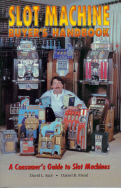Find Loose Slots... Play Online!
Roxy Palace has some of the loosest slots on the web. Their selection is huge and with less overhead, employee costs and taxes than your typical brick and mortar casino, they can afford to give back a bigger percentages of bets back to the customer. If you're looking for loose slots, play online!

Slot Machine Buyer's Handbook
by David Saul
Provides information to help you know what you're buying. Designed to help prospective buyers gain expertise and self-confidence to avoide costly mistakes. Features the Collector's Comparison, a list of 950 slot machines telling the date of introduction, type of machine, manufacturer, value range, rarity, marketability and reliability.
Slots - How They Work, Old-Style
Classic old-style slot machines run an elaborate configuration of gears and levers. The central element is a metal shaft, which supports the reels. This shaft is connected to a handle mechanism that gets things moving. A braking system brings the spinning reels to a stop, and sensors communicate the position of the reels to the payout system. A coin detector initially registers that a coin has been inserted and unlocks a brake so the handle can move.
The design includes three reels mounted on a central shaft. The central shaft also supports three notched discs, which are connected to the three reels. A second shaft below the central shaft supports a kicker, a piece of metal comprising three paddles. The kicker paddles are lined up so they can push against the notches on the three discs. The second shaft also supports a series of connected stoppers, teeth that lock into the notches on the discs.
The kicker and the stoppers are both connected to springs, which hold them in a standby position. The kicker is held in place behind the discs, while the stoppers are held up against the discs, locking them into place.
So here is what happens when a player pulls the handle:
• The handle rotates a hook mechanism, which grabs hold of the kicker, pulling it forward (toward the player).• A catch on the opposite end of the kicker grabs a control cam piece and pivots it forward. This rotates a series of gears connected to the control cam. A spring pulls the control cam back to its original position, but the gear assembly slows it down considerably -- the gears act as a mechanical delay.• When the control cam is pivoted forward, it releases a spring-mounted cam plate extending across the back of the machine.• The control cam also pulls the stoppers away from the notched discs. As the kicker keeps moving, it pushes the stoppers against several catches on the cam plate. These hold the stoppers in place, so the discs and reels can rotate freely.• As the handle continues to move the kicker, the kicker paddles push the discs forward briefly. When the handle is pulled all the way back and the kicker has passed the discs, the bottom of the hook mechanism moves up against a slanted surface. The slant pivots the hook forward, which causes it to release the kicker.• The kicker spring jerks the kicker backward at a good speed. The kicker paddles hit the notches on the discs, spinning the reels rapidly.• While all of this is happening, the control cam is slowly returning to its original position. When it does return, it pushes the cam plate back, which releases the stoppers.
The different catches holding onto the different stoppers are positioned so that the cam plate will release the stoppers one at a time. Each stopper springs forward and locks into a notch, holding the reel in position.
From the player's point of view, here's how it looks. The player pulls the handle. There is a clunk, and the three reels start spinning. Then the three reels stop abruptly one at a time, followed by the payout (if necessary). The "stopping one at a time" part builds suspense. If the first reel stops on the jackpot symbol, then you have to wait for the next reel to stop to see if it is a jackpot, and then finally the third. If all three display the right symbol, the player wins.
Conventional mechanical slot machines eventually gave rise to electrical machines that worked on similar principles. In an electrical machine, the reels are spun by motors and the stoppers are generally activated by electromagnets, but the game basically plays out the same way. Electrical machines have more sophisticated money-handling systems, like those you might find in a vending machine, and flashier light and sound displays.
In both types of systems, once the reels have come to a stop, the slot machine needs to read whether the player has won or lost. So thatss the "old school" slot machine mechanism.

